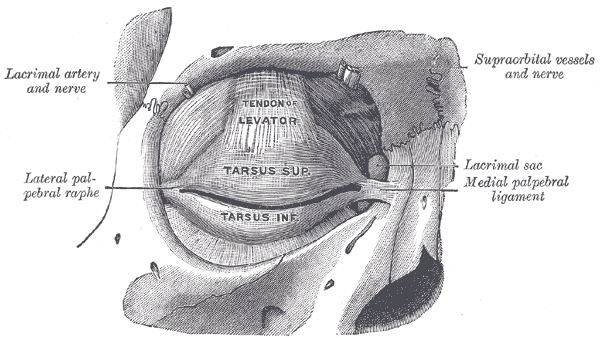
Anatomy
Head and Neck
The superior tarsal muscle is innervated by which of the following:
Answer:
The superior tarsal muscle is a collection of smooth muscle fibres in companion with the levator palpebrae superioris, innervated by postganglionic sympathetic fibres from the superior cervical ganglion which helps to maintain upper eyelid opening.Eyelids
Anatomy / Head and Neck / Orbit and Eye
Last Updated: 23rd May 2025
The upper and lower eyelids are anterior structures that protect the eyeball when closed. The space between the eyelids is the palpebral fissure.
Layers
The layers of the eyelids consist of (from anterior to posterior)
- skin
- subcutaneous tissue
- voluntary muscle
- the orbital septum (an extension of periosteum which attaches to the tarsus)
- the tarsus (a plate of dense connective tissue which provide the major support for the eyelid)
- conjunctiva (a thin membrane, composed primarily of stratified squamous epithelium, which covers the posterior surface of each eyelid before reflecting onto the sclera of the eyeball).
The upper and lower eyelids are basically the same, except for the addition of two muscles in the upper eyelid, the levator palpebrae superioris and the superior tarsal muscle, and the inferior tarsal muscle in the lower eyelid.
![By Henry Vandyke Carter [Public domain], via Wikimedia Commons](https://mrcemsuccess.com/wp-content/uploads/2017/01/Eyelid.png)
Layers of the Eyelids. (Image by Henry Vandyke Carter [Public domain], via Wikimedia Commons)

Right eye in sagittal section, with structures of the orbital septum within blue markings. (Image by Mikael Häggström, used with permission, Public domain, via Wikimedia Commons)
Muscles
The orbicularis oculi muscle is innervated by the facial nerve and closes the eyelids. Loss of function of the orbicularis oculi causes an inability to close the eyelids tightly and a drooping of the lower eyelid (ectropion) resulting in spillage of tears. This leads to drying of the cornea, with subsequent ulceration and secondary infection.
The levator palpebrae superioris muscle originates from the roof of the orbit and inserts into the superior tarsus. It is innervated by the oculomotor nerve and acts to raise the upper eyelid. Loss of function of the levator palpebrae superioris muscle results in a complete ptosis.
The superior tarsal muscle is a collection of smooth muscle fibres in companion with the levator palpebrae superioris, innervated by postganglionic sympathetic fibres from the superior cervical ganglion, which helps to maintain upper eyelid opening. Loss of function of the superior tarsal muscle results in a partial ptosis.

Muscles of the Eyelids. (Image by Henry Vandyke Carter [Public domain], via Wikimedia Commons)
Innervation
The sensory innervation of the eyelids and conjunctiva is from:
- the supraorbital nerve (ophthalmic nerve)
- the supratrochlear nerve (ophthalmic nerve)
- the infratrochlear nerve (ophthalmic nerve)
- lacrimal branches (ophthalmic nerve)
- the infraorbital nerve (maxillary nerve)
![By Patrick J. Lynch, medical illustrator (Patrick J. Lynch, medical illustrator) [CC BY 2.5], via Wikimedia Commons](https://mrcemsuccess.com/wp-content/uploads/2016/07/Face-innervation.png)
Cutaneous Innervation of the Head. (Image by Patrick J. Lynch, medical illustrator [CC BY 2.5], via Wikimedia Commons)
Glands
Embedded in the tarsal plates are modified sebaceous tarsal glands (Meibomian glands) which empty an oily substance onto the free margin of each eyelid that increases the viscosity of tears and decreases the rate of evaporation of tears from the surface of the eyeball.
Blockage and inflammation of a tarsal gland is a chalazion and is on the inner surface of the eyelid. External sebaceous and sweat glands associated with the eyelash follicles may also become blocked and inflamed causing a stye on the edge of the eyelid.
Report A Problem
Is there something wrong with this question? Let us know and we’ll fix it as soon as possible.
Loading Form...
- Biochemistry
- Blood Gases
- Haematology
| Biochemistry | Normal Value |
|---|---|
| Sodium | 135 – 145 mmol/l |
| Potassium | 3.0 – 4.5 mmol/l |
| Urea | 2.5 – 7.5 mmol/l |
| Glucose | 3.5 – 5.0 mmol/l |
| Creatinine | 35 – 135 μmol/l |
| Alanine Aminotransferase (ALT) | 5 – 35 U/l |
| Gamma-glutamyl Transferase (GGT) | < 65 U/l |
| Alkaline Phosphatase (ALP) | 30 – 135 U/l |
| Aspartate Aminotransferase (AST) | < 40 U/l |
| Total Protein | 60 – 80 g/l |
| Albumin | 35 – 50 g/l |
| Globulin | 2.4 – 3.5 g/dl |
| Amylase | < 70 U/l |
| Total Bilirubin | 3 – 17 μmol/l |
| Calcium | 2.1 – 2.5 mmol/l |
| Chloride | 95 – 105 mmol/l |
| Phosphate | 0.8 – 1.4 mmol/l |
| Haematology | Normal Value |
|---|---|
| Haemoglobin | 11.5 – 16.6 g/dl |
| White Blood Cells | 4.0 – 11.0 x 109/l |
| Platelets | 150 – 450 x 109/l |
| MCV | 80 – 96 fl |
| MCHC | 32 – 36 g/dl |
| Neutrophils | 2.0 – 7.5 x 109/l |
| Lymphocytes | 1.5 – 4.0 x 109/l |
| Monocytes | 0.3 – 1.0 x 109/l |
| Eosinophils | 0.1 – 0.5 x 109/l |
| Basophils | < 0.2 x 109/l |
| Reticulocytes | < 2% |
| Haematocrit | 0.35 – 0.49 |
| Red Cell Distribution Width | 11 – 15% |
| Blood Gases | Normal Value |
|---|---|
| pH | 7.35 – 7.45 |
| pO2 | 11 – 14 kPa |
| pCO2 | 4.5 – 6.0 kPa |
| Base Excess | -2 – +2 mmol/l |
| Bicarbonate | 24 – 30 mmol/l |
| Lactate | < 2 mmol/l |

